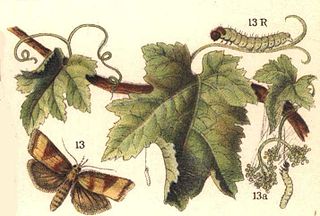
The Sparganothini are a tribe of tortrix moths.

Gutierrezia is a genus of flowering plants in the family Asteraceae, native to western North America and western South America. Plants of this genus are known generally as snakeweeds or matchweeds. Some species have been called greasewood. They are annual or perennial plants or subshrubs with yellow or white flowers.

Gutierrezia sarothrae is a species of flowering plant in the family Asteraceae known by the common names broom snakeweed, broomweed, snakeweed, and matchweed. It is a subshrub native to much of the western half of North America, from western Canada to northern Mexico, and can be found in a number of arid, grassland, and mountain habitats. It can be toxic to livestock in large quantities, due mainly to the presence of saponins.
Synalocha is a genus of moths belonging to the family Tortricidae.
Syllonoma longipalpana is a species of moth of the family Tortricidae. It is found in the United States in South and North Carolina.
Accuminulia longiphallus is a species of moth of the family Tortricidae. It was first described by John W. Brown in 1999 and is found in Chile.
Quasieulia jaliscana is a species of moth of the family Tortricidae. It is found in the Mexican states of Jalisco, Oaxaca, Puebla and Veracruz.
Transtillaspis tucumana is a species of moth of the family Tortricidae. It is found in Tucumán Province, Argentina.
Argentulia montana is a species of moth of the family Tortricidae. It is found in Argentina and Chile.
Pseudapina lanceovalva is a species of moth of the family Tortricidae. It is found in Venezuela.
Gorytvesica ebenoptera is a species of moth of the family Tortricidae. It is found in Morona-Santiago Province, Ecuador.
Gorytvesica sachatamiae is a species of moth of the family Tortricidae. It is found in Pichincha Province, Ecuador.
Transtillaspis plagifascia is a species of moth of the family Tortricidae. It is found in Ecuador in Tungurahua, Azuay and Loja provinces.
Transtillaspis emblema is a species of moth of the family Tortricidae. It is found in Napo Province, Ecuador.
Eugnosta brownana is a species of moth of the family Tortricidae. It is found in Texas, New Mexico, Arizona and possibly Mexico.
Argyrotaenia loxonephes is a species of moth of the family Tortricidae. It is found in Argentina.
Geogepa stenochorda is a species of moth of the family Tortricidae. It is found in Japan on the islands of Hokkaido, Honshu, Shikoku and Kyushu and in China in the province of Anhui.
Geogepa monticola is a species of moth of the family Tortricidae. It is found on the island of Honshu in Japan. The habitat consists of subalpine and alpine forests.
Xenothictis gnetivora is a species of moth of the family Tortricidae. It is found in Papua New Guinea.
Asteromyia gutierreziae is a species of gall midges in the family Cecidomyiidae.


